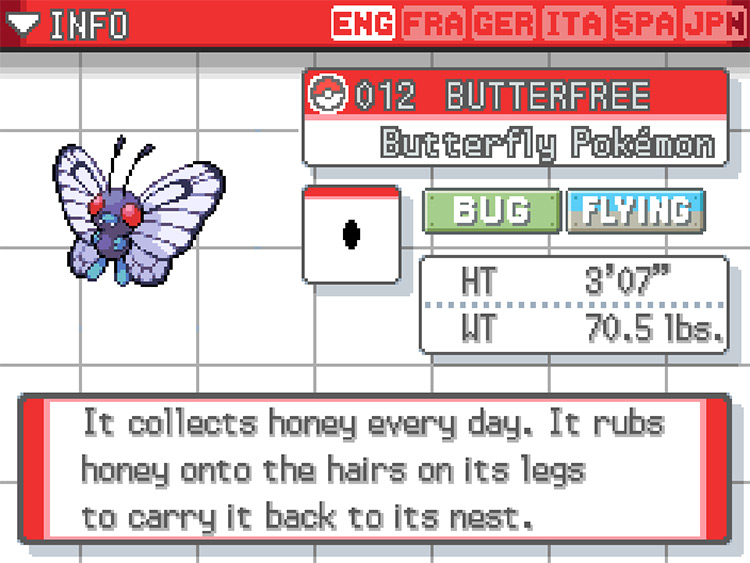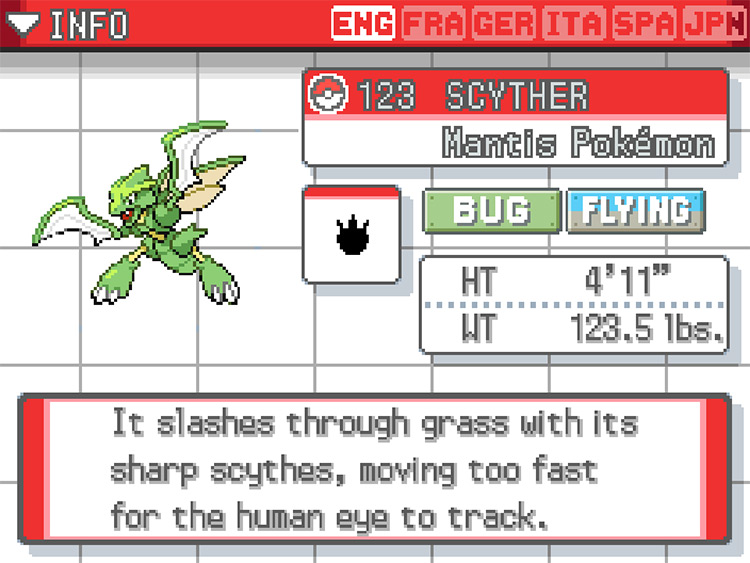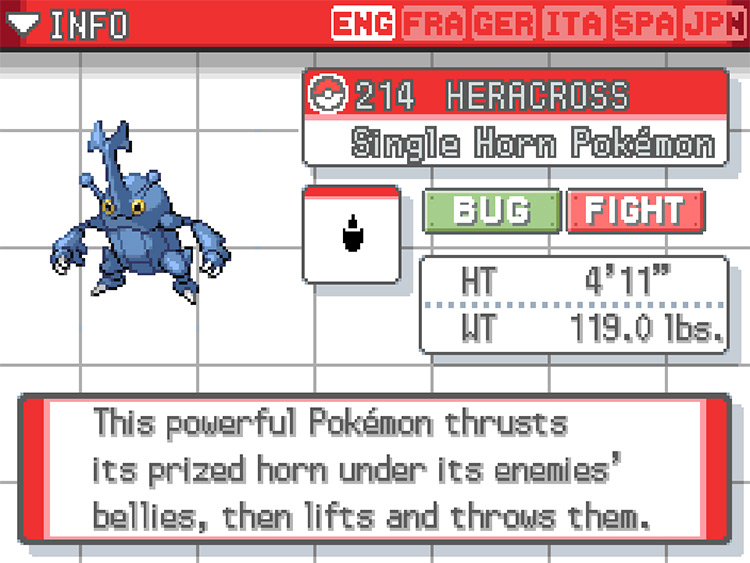The Johto remakes are no exception on these critters. And they offer a pretty wide selection of underrated Bug-types to pick from. Here are my picks for the Best Bug-types for your team.
3. Butterfree
Butterfree has always been unfairly overlooked. As anyone who’s completed a Nuzlocke challenge will tell you, Butterfree is all but guaranteed to be your best Pokémon in the early game. Having a fully evolved Pokémon with Confusion at level 10 makes you an unstoppable force against most teams, until Butterfree’s power eventually falls off later on. So we’ll start our move pool with the aforementioned Confusion, which’ll be your primary move against the horde of Poison-types that you’ll come up against in the early stages of the game. Butterfree will learn its flying-type STAB move, Gust, at level 16. While this isn’t a powerhouse move, it’ll still come in handy against Pokémon who aren’t susceptible to Confusion. Unfortunately, Butterfree lacks any major Bug-type STAB moves, so we’ll build the rest of its move set around some status moves. At level 12, Butterfree will learn Stun Spore, Sleep Powder, and Poisonpowder – three status moves that are excellent for this stage in the game. Any of these moves work, but personally I like to equip Butterfree with Sleep Powder and Stun Spore, since the Poison-type Pokémon that are abundant in the early game will shrug off a Poisonpowder. Once Butterfree’s strength starts to dip around the time of Whitney’s Gym in Goldenrod City, move away from using Butterfree as an offensive Pokémon, and more towards a utility Pokémon. So long as it can take one hit from it first, Butterfree’s Sleep Powder can be the difference between victory and defeat against Whitney’s deadly Miltank. How to catch: You can catch Butterfree by competing in the National Park Bug Catching Contest on Tuesdays, Thursdays, and Saturdays. Alternatively, you can take a Pokémon who can learn Headbutt to Ilex Forest, and speak to the move tutor there. Once your Pokémon has headbutt, use it on a tree in Ilex Forest for a chance to encounter a Butterfree.
2. Scyther
I know what you’re thinking – why not Scizor? Scizor is a rare example of an evolution that’s not strictly better than its pre-evolved form. The two Pokémon have the same base stat total, with the points merely being distributed differently. And the change in typing from Bug/Flying to Bug/Steel also doesn’t make Scizor necessarily better, just different. If you want to see a rundown on how to catch & use Scizor, check out my article on the best Steel-types for this gen. Now, on to Scyther. Scyther can be a valuable member of your team all the way through to the endgame, so long as you build it right. We’ll be focusing Scyther’s moveset on pure offense, setting it up to be a Bug/Flying sweeper. Swords Dance is up first, a status move which will sharply buff Scyther’s already high physical attack into a sharpened edge with which to one-shot enemy Pokémon. Pick up the TM from Goldenrod City Game Corner. For Bug-type STAB we’ll use X-scissor, which Scyther will learn naturally at level 41. On the long road to learning X-scissor we can make do with a mix of U-turn and Pursuit. U-Turn can be learned from a TM you’ll receive as a gift for beating the Azalea Town Gym. It’s a high power Bug-type move that also switches Scyther out from battle – handy to get it away from any threats that might one-shot it. While U-Turn is a great utility move in its own right, it’s not ideal as a primary offensive move, as the switch-out that follows the damage is mandatory. To avoid switching Scyther out every time we want it to do damage, we’ll be using Pursuit to back it up. Pursuit, while not a Bug-type move, will still take care of any Psychic-type Pokémon that we might want to target with U-Turn without taking Scyther off of the battlefield. Scyther will learn Pursuit naturally at level 9. For its final move, Wing Attack or Aerial Ace both work as Flying-type STAB – but I personally use Wing Attack, so I can keep the Aerial Ace TM for my primary Flying-type Pokémon. How to catch: Like Butterfree, Scyther can be caught in the Bug Catching Contest on Tuesdays, Thursdays, and Saturdays.
1. Heracross
Anyone who’s played the Sinnoh games knows the power that Heracross can bring to a team. Heracross’s mammoth attack stat, as well as its huge array of high damage moves, make it a perfect choice as both a Bug and Fighting-type Pokémon. Heracross can learn Aerial Ace as early as level 13, so for a moveset we’ll start there. Then we can follow it up with Brick Break at level 19 for our first piece of Fighting-type STAB. Once Heracross hits level 37, we can add Close Combat to the mix for some one-shot tier Fighting-type damage. Heracross has to wait a long time to get some reliable Bug-type STAB, but the journey is worth it. It’ll learn the enormous Megahorn at level 55. Feel free to compensate for this Bug-type void with U-turn until then. This is my preferred setup for Heracross, but if you aren’t worried about Close Combat’s low PP, you can swap out Brick Break to give Heracross a bit more flexibility. Iron Defense can be learned from the move tutors in the Frontier Front, and will set up Heracross to take some hits from any Pokémon which could survive a Close Combat or a Megahorn. Earthquake and Rock Tomb work too, and go a long way to covering up Heracross’ weakness to Fire-type attacks. How to catch: Heracross can be found by using Headbutt on trees all over the Johto region. I personally recommend picking it up early by headbutting a tree in Azalea Town.


